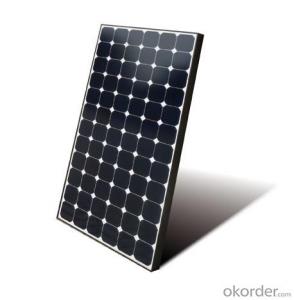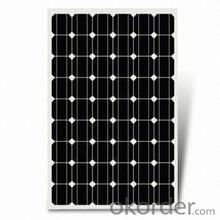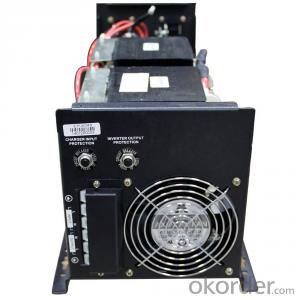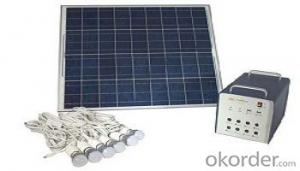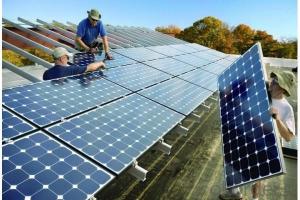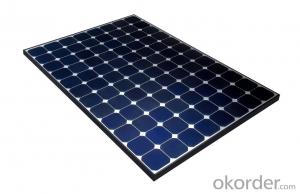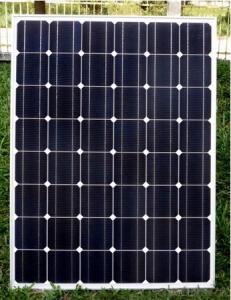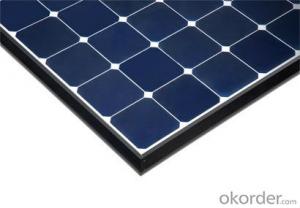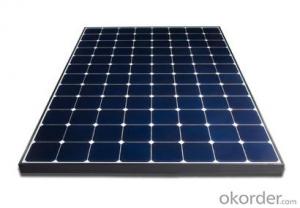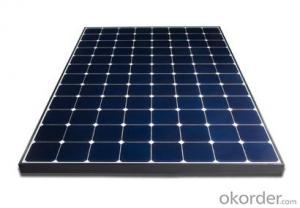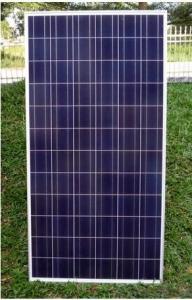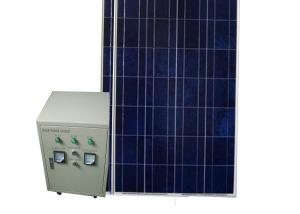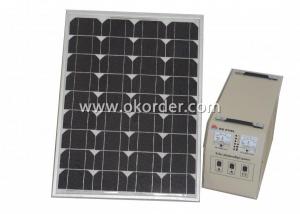Solar Energy Systems Canada - CNBM On Grid System 900W with Certificate UL TUV CE
- Loading Port:
- Shanghai
- Payment Terms:
- TT OR LC
- Min Order Qty:
- 100 watt
- Supply Capability:
- 1000 watt/month
OKorder Service Pledge
OKorder Financial Service
You Might Also Like
Specification
CNBM On Grid System 900W with Certificate UL TUV CE
Product description
A grid-connected photovoltaic power system, or grid-connected PV system is anelectricity generating solar PV system that is connected to the utility grid. A grid-connected PV system consists of solar panels, one or several inverters, a power conditioning unit and grid connection equipment. They range from small residential and commercial rooftop systems to large utility-scale solar power stations. Unlike stand-alone power systems, a grid-connected system rarely includes an integrated battery solution, as they are still very expensive. When conditions are right, the grid-connected PV system supplies the excess power, beyond consumption by the connected load, to the utility grid.
Connection of the photovoltaic power system can be done only through an interconnection agreement between the consumer and the utility company. The agreement details the various safety standards to be followed during the connection.[4]
Grid-connected PV can cause issues with voltage regulation. The traditional grid operates under the assumption of one-way, or radial, flow. But electricity injected into the grid increases voltage, and can drive levels outside the acceptable bandwidth of ±5%.[8]
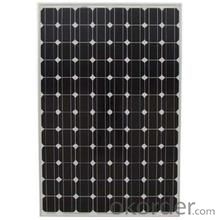
Application
Industrial
Commercial
Residential
Feature
Residential, grid-connected rooftop systems which have a capacity more than 10 kilowatts can meet the load of most consumers.[2] They can feed excess power to the grid where it is consumed by other users. The feedback is done through a meter to monitor power transferred. Photovoltaic wattage may be less than average consumption, in which case the consumer will continue to purchase grid energy, but a lesser amount than previously. If photovoltaic wattage substantially exceeds average consumption, the energy produced by the panels will be much in excess of the demand. In this case, the excess power can yield revenue by selling it to the grid. Depending on their agreement with their local grid energy company, the consumer only needs to pay the cost of electricity consumed less the value of electricity generated. This will be a negative number if more electricity is generated than consumed.[3] Additionally, in some cases, cash incentives are paid from the grid operator to the consumer.
Packaging
With carton and box
- Q: Can solar energy systems be used in disaster relief efforts?
- Indeed, solar energy systems have proven to be effective in disaster relief endeavors, gaining popularity and significance in such situations. When calamities strike, they frequently disrupt the electricity supply, leaving affected areas devoid of power for extended periods, ranging from days to even weeks. This absence of electricity hinders relief efforts, impeding the provision of basic necessities such as lighting, medical care, communication, and clean water. In contrast, solar energy systems offer a dependable and sustainable power source in these circumstances. Consisting of solar panels that convert sunlight into electricity, these systems can energize various devices and appliances. They can be rapidly deployed to disaster-stricken regions, providing immediate access to electricity without relying on conventional power grids. There are numerous advantages to employing solar energy systems in disaster relief operations. Firstly, solar power is renewable and abundant, ensuring a continuous electricity supply even during prolonged emergencies. Secondly, these systems typically require minimal maintenance, decreasing the need for constant fuel supply or repairs. Consequently, they are more cost-effective and reliable in disaster-prone areas. Solar energy systems can be utilized in various ways during disaster relief endeavors. For instance, they can power mobile charging stations, enabling individuals to charge their phones and stay connected with their loved ones. Solar-powered lighting can illuminate temporary shelters, hospitals, and walkways, enhancing safety and security for victims and aid workers alike. Additionally, solar energy can power water purification systems, guaranteeing access to clean drinking water in regions where water infrastructure has been damaged or contaminated. Moreover, solar energy systems can be seamlessly integrated into existing relief infrastructure. Hospitals, schools, and community centers can have solar panels installed on their roofs, ensuring a reliable electricity source for critical operations. This reduces reliance on diesel generators or other fossil fuel-powered alternatives, which tend to be costly, noisy, and emit harmful pollutants. In conclusion, solar energy systems are immensely advantageous in disaster relief efforts. They offer a sustainable and dependable power source, facilitating essential services and enhancing overall relief operations. As the world grapples with increasingly frequent and severe natural disasters, the utilization of solar energy systems in disaster relief will continue to gain significance.
- Q: What are the environmental benefits of using solar energy systems?
- Solar energy systems have numerous environmental benefits. Firstly, solar power is a clean and renewable energy source, meaning it does not produce harmful greenhouse gas emissions like fossil fuels. This helps mitigate climate change and reduce air pollution. Additionally, solar energy reduces reliance on non-renewable resources such as coal or natural gas, conserving these valuable resources for future generations. Moreover, solar panels require minimal water for maintenance compared to other energy sources, conserving water resources. Overall, solar energy systems play a crucial role in transitioning towards a more sustainable and environmentally friendly energy future.
- Q: Can a solar energy system be installed on a concrete roof?
- Yes, a solar energy system can be installed on a concrete roof. In fact, concrete roofs are one of the most ideal surfaces for solar panel installation. Concrete roofs are typically flat, stable, and durable, providing a solid foundation for the panels. Additionally, concrete roofs often have ample space and are not obstructed by nearby trees or buildings, allowing for maximum sunlight exposure. The installation process involves securing the panels to the concrete roof using special mounting systems designed to withstand the weight and ensure a secure attachment. Overall, concrete roofs are a great choice for solar energy system installation.
- Q: Can solar energy systems be used for powering schools or educational institutions?
- Yes, solar energy systems can be used to power schools or educational institutions. In fact, many schools and educational institutions around the world are adopting solar energy systems as a sustainable and clean source of power. Solar energy systems, such as solar panels, can be installed on the roofs of school buildings or in open spaces on the school campus to harness the power of the sun. This renewable energy source can generate electricity to meet a significant portion of the school's power needs. There are several benefits to using solar energy systems in schools. Firstly, solar power is a clean source of energy that does not produce harmful emissions or contribute to air pollution, thus helping to reduce the carbon footprint of the educational institution. Additionally, solar energy systems can help schools save money on their electricity bills in the long run, as they can generate electricity for free once the initial installation costs are recovered. These savings can be reinvested in educational resources or programs. Moreover, integrating solar energy systems into schools can provide valuable educational opportunities for students. By utilizing solar power, schools can educate their students about renewable energy, climate change, and the importance of sustainable practices. Students can learn about the science behind solar energy, the benefits of clean energy sources, and the role they can play in promoting a greener future. Furthermore, solar energy systems can also serve as a backup power source during power outages or emergencies, ensuring uninterrupted power supply to the school, especially during critical times such as exams or in areas with unreliable electricity infrastructure. In conclusion, solar energy systems can indeed be used to power schools or educational institutions. They offer numerous benefits, including reduced carbon emissions, cost savings, educational opportunities, and backup power capabilities. By embracing solar power, schools can demonstrate their commitment to sustainability, inspire students, and contribute to a cleaner and greener future.
- Q: Can solar energy systems be used in areas with limited water resources?
- Areas with limited water resources can use solar energy systems effectively. Solar energy systems rely on the sun's radiation to produce electricity or heat, eliminating the need for large amounts of water. Unlike traditional power plants, which rely on water for cooling and steam generation, solar energy systems do not require water-intensive processes. Solar photovoltaic (PV) systems convert sunlight directly into electricity, and they operate without the need for water. These systems consist of solar panels that capture sunlight and convert it into electricity through the photovoltaic effect. Therefore, they can be installed in areas with limited water resources without any impact on their functionality. Solar thermal systems, on the other hand, use sunlight to heat a fluid, such as water or oil, which is then used for electricity generation or heating. While these systems may require some water for cleaning or maintenance, the water requirements are relatively low compared to traditional power plants. Additionally, advancements in solar thermal technology have led to the development of dry-cooling systems that significantly reduce water consumption. Furthermore, solar energy systems can be combined with other technologies to further minimize water usage. Solar-powered desalination plants, for example, can convert seawater or brackish water into freshwater through reverse osmosis, without relying on traditional energy sources or fossil fuels. This integration of solar energy and desalination can provide clean drinking water in areas with limited freshwater resources, alleviating the strain on water supplies. In conclusion, solar energy systems are suitable for areas with limited water resources as they primarily operate on sunlight and require minimal water for functioning. Using solar power not only reduces greenhouse gas emissions and dependence on fossil fuels but also addresses water scarcity issues in these regions.
- Q: How does solar energy affect property value?
- Solar energy can significantly increase property value by reducing energy costs, offering potential tax incentives, and appealing to environmentally conscious homebuyers.
- Q: What is the role of solar panel cleaning in maintaining optimal performance?
- Solar panel cleaning plays a crucial role in maintaining optimal performance by removing dirt, dust, bird droppings, and other debris that can accumulate on the surface of the panels. These contaminants can significantly reduce the panel's ability to absorb sunlight and convert it into electricity. Regular cleaning ensures maximum sunlight absorption, increasing the efficiency and output of the solar panels.
- Q: Are solar energy systems noisy?
- No, solar energy systems are not noisy. They operate silently as they convert sunlight into electricity without any moving parts or mechanical components.
- Q: How do solar energy systems impact the affordability of electricity?
- Solar energy systems have a significant effect on the affordability of electricity. One of the primary advantages of solar energy is its ability to provide a constant and renewable power source. By harnessing the energy from the sun, solar systems can generate electricity without relying on fossil fuels, which can be volatile in price and deplete over time. This stability in energy costs assists in lowering the overall price of electricity. Furthermore, solar energy systems aid homeowners and businesses in saving money on their utility bills. Once installed, solar panels produce electricity at no expense, reducing the need for grid power and decreasing monthly electricity expenses. In some cases, solar energy systems can even generate surplus electricity that can be sold back to the grid, further offsetting costs. Additionally, solar energy systems often come with financial incentives and tax credits from governments and utility companies. These incentives can help decrease the initial costs of installing solar panels, making them more affordable for individuals and businesses. As solar technology progresses and becomes more efficient, the cost of equipment and installation has been consistently decreasing, making solar energy systems even more accessible. In summary, solar energy systems have a positive impact on the affordability of electricity by providing a sustainable and cost-effective alternative to traditional power sources. By reducing dependence on fossil fuels, lowering energy bills, and offering financial incentives, solar energy systems play a crucial role in making electricity more affordable for both individuals and society as a whole.
- Q: How do solar energy systems impact the grid?
- Solar energy systems impact the grid by injecting clean and renewable energy into the system, reducing the overall demand for fossil fuel-based electricity. This helps to decrease greenhouse gas emissions and promote a more sustainable and environmentally friendly energy sector. However, solar energy systems also present challenges for grid operators due to their intermittent nature, as they only produce electricity when the sun is shining. Grid integration and management strategies are required to balance the variations in solar energy generation and ensure grid stability and reliability.
Send your message to us
Solar Energy Systems Canada - CNBM On Grid System 900W with Certificate UL TUV CE
- Loading Port:
- Shanghai
- Payment Terms:
- TT OR LC
- Min Order Qty:
- 100 watt
- Supply Capability:
- 1000 watt/month
OKorder Service Pledge
OKorder Financial Service
Similar products
Hot products
Hot Searches
Related keywords
